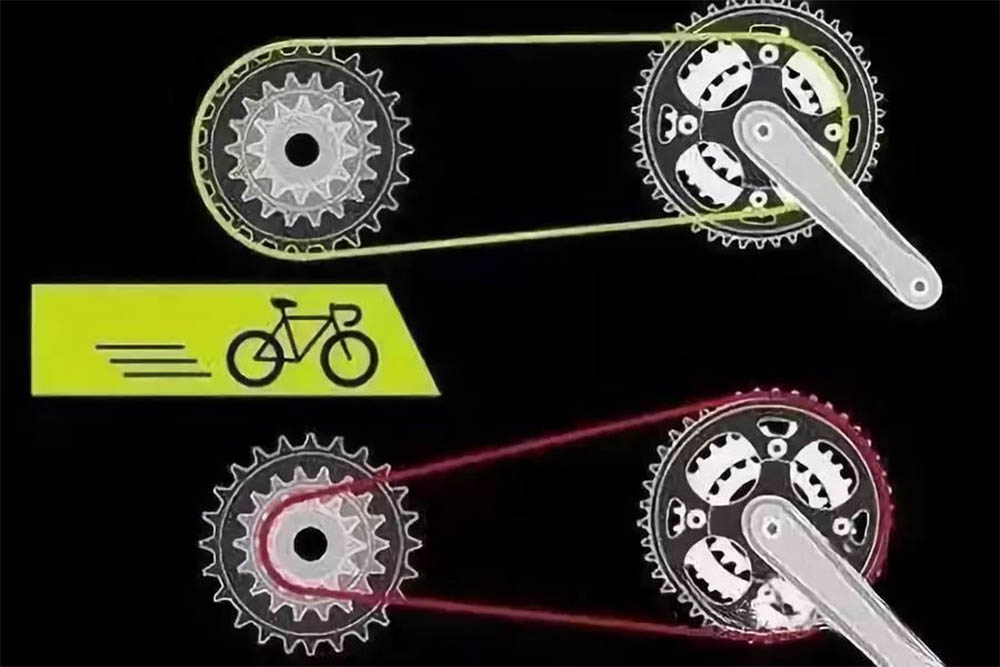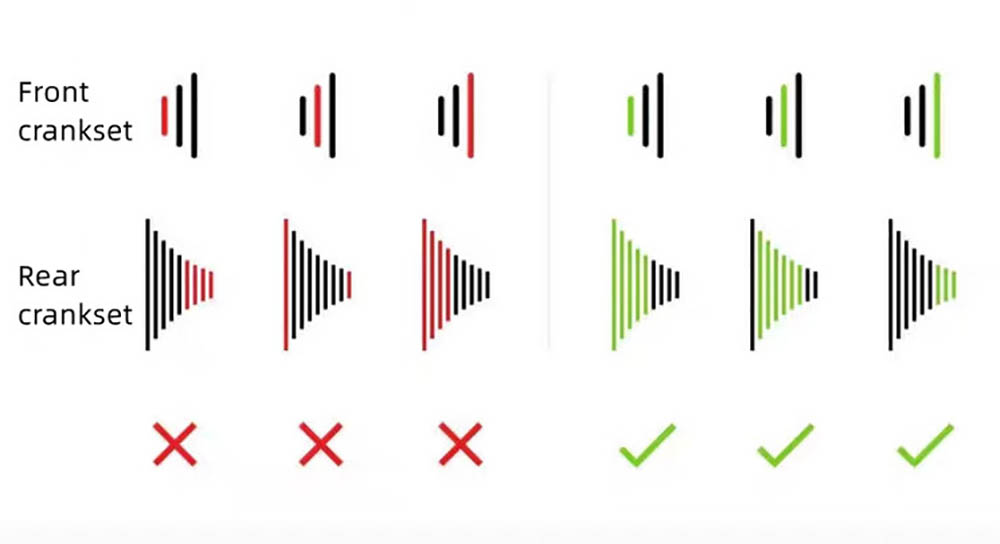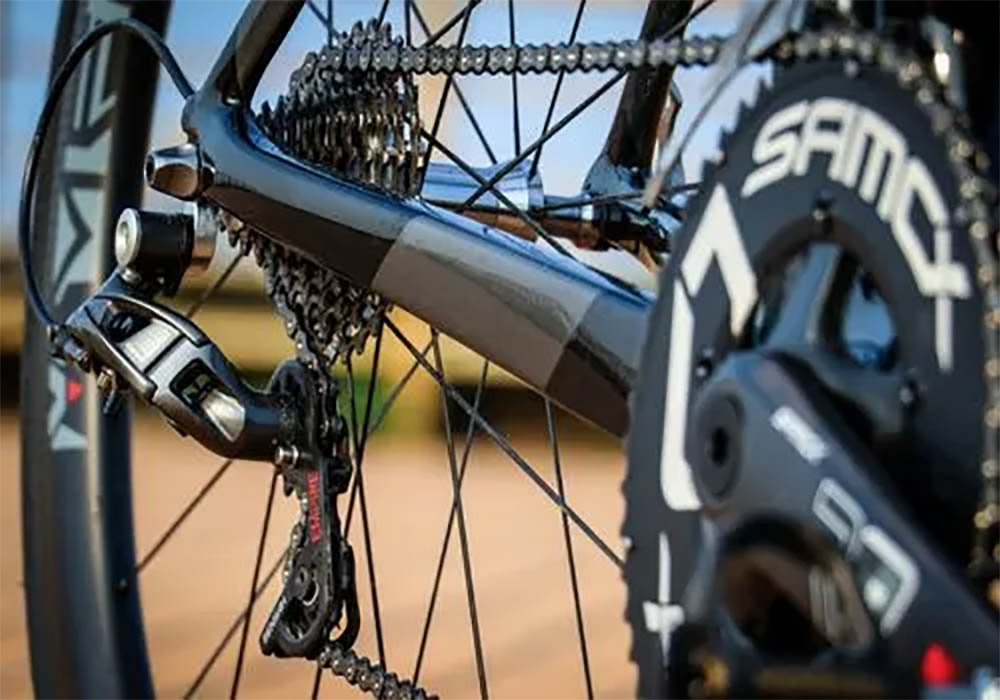How to properly use electric bike transmission and shifting skills
Hello everyone, I believe many of you do not understand how to shift an electric bike and shifting tips, including how to properly use electric bike transmission, but it does not matter, next we will share some knowledge points about how to shift a ebike and shifting skills and how to shift a bike correctly.

How to shift an electric bike?
You can adjust the gear ratio of the derailleur by finger paddle to determine the strength of the pedals and the speed of travel.
The gearing combinations are 1-1, 1-2, 1-3, 1-4, 2-2, 2-3, 2-4, 2-5, 2-6, 3-5, 3-6, 3-7, 3-8 in order of speed.
Under normal conditions, 2-4, 2-5 and 2-6 gears can handle most road conditions, and the speed range is between 15 km/h and 22 km/h without powering up.
A few tips for shifting your bike
It is not appropriate to choose too big or too small gear ratios. Generally speaking, you can use a slightly smaller gear ratio for the first few kilometers of warm-up, so that your muscles can be active. The moment after the start, adjust the lighter gear, because it is easy to accelerate suddenly and sprint with a fast frequency, and all the reservations will be exhausted in a moment, but the distance and timing must be very accurate. Because amateur riders are in different physical condition, the weight of the equipment is also very different (generally light and heavy cars can differ by one to two teeth at the back, and the same pedaling frequency to travel), but although the light car acceleration and climbing is very good, but the impact of wind resistance is greater than the heavy car, so the use of light cars must have better shifting skills to play its strengths, the same weight and light weight players are also the same The reasoning to control their own gearing but tooth ratio and smaller tooth ratio are bad, many enthusiasts think that the front behind small, you can get a better speed with frequency, in fact, this is not true, because the large rotation ratio will lead to more power per foot, and lower frequency, making the blood circulation slower, more likely to lead to muscle hypoxia, while 11 teeth or 12 teeth of the flying piece are the whole drivetrain is not Durable, and really these are used in the downhill at high frequency and high speed.
Novices often see a large slope immediately when the gearing, using a smaller transmission ratio, which directly leads to a sudden rise in frequency, in the absence of muscle adaptation, will immediately feel muscle fatigue, and because of the tooth ratio at once too light, will lead to an immediate drop in speed, when see other riders beyond the time will also lead to the already sudden fatigue of the legs frequency again, so that as long as after one or two slopes, the So the correct climbing shift should be the car has traveled to the half-slope, the foot began to feel the pressure rise, and then in the beginning of the shift, and the range of adjustment is generally 2 pieces of fly or 3 pieces of fly at a time, depending on the specific slope elevation to decide, which not only requires physical strength also needs experience, in the early climbing standing pedal can also provide a greater speed, and can delay the gear ratio In the early stage of climbing, standing pedaling can also provide greater speed, and it can delay the gear ratio from becoming smaller, so that the feet have sufficient time to adjust to the frequency.
Here is a tip, when the front disc is backing out of the gears, your foot should be a little lighter, so that the chain pressure can be relieved a little and the chain can be backed out of the small disc more easily.
The same trick should be used when the chain is very tight at the half-slope, so that the whole system can be protected.
Since the specific situation of bikes and amateurs is different, we will not provide specific reference standards here.
Generally, using large disc to large fly and small disc to small fly is not the correct way to shift. Large disc to large fly will make the chain tension too big, which will have some damage to the rear paddle, and this way of shifting will also cause the friction to increase because of the chain tension too big.
And small disc to small fly is also an incorrect shifting, because it will make the chain too loose, which will cause failure when it goes over severe bumps (such as chain striking the frame, chain shaking touching the edge of the tire), and both small disc and small fly are fast wearing parts in the front and rear drivetrain.
So the high speed should be big disc to small fly, and climbing light should also be small disc to big fly, so that is the more correct way to use the gearing.
In addition, the 22-tooth small disk of mountain bikes is actually a part of the frequency of use, one of the main uses of this small disk is to prevent the chain from falling off directly when the second layer of violent bumps, and the use of 22-tooth small disk on the big fly is easy to cause the rear wheel to slip and lose speed, so mountain bike shifting should try to avoid using this layer, only in a small amount when the super steep slope, and once this layer is used Be sure to pay attention to the smoothness of the pedals, otherwise it will be difficult to climb steep slopes.
Electric bicycle speed difference:
I. The number of tooth discs of the three are different:
1、21 speed: 14~28.
2、24 speed: 11~ 30 (11-13-15-18-21-24-28-32).
3、27 speed: 11~ 30 (11~ 32).
Second, the transmission ratio of the three is different (the number of discs divided by the number of flywheels is the transmission ratio):
1、21 speed: transmission ratio 3.43, small transmission ratio 1.
2, 24 speed: ratio 3.82, small ratio 0.73 (0.69).
3, 27 speed: ratio 4, small ratio 0.73 (0.69).
How to adjust the speed of a bicycle with variable speed
The role of the bicycle shifting system is to change the chain and different front and rear size of the gear disc to change the speed of the car. The front is 1 gear, the back with 1234 gears to use, the front is 2 gears, the back with 234567 gears to use, the front is 3 gears, the back with 789 gears to use.
According to the visual inspection of the slope of the road to decide, generally use the front 2 after 5 gears to accelerate, the larger the transmission value, the faster the speed, but riding laborious.
The size of the front and rear derailleur determines the strength of the bike when rotating the pedals. According to the ability of different riders, you can adjust the speed of the bike by adjusting the size of the front and rear derailleurs, or respond to different road sections and road conditions.
How to use the electric bike transmission correctly?
The following is an example of a 27-speed mountain bike transmission. The so-called 27-speed refers to three cogs and a rear 9-piece flywheel, i.e. 3 x 9 = 27. The correct corresponding gear ratio should be:

Please use the transmission correctly, incorrect gearing will put a burden on the shifting system and, with long-term use, will shorten the life of the shifting. Riding with wrong gears, although you can drive normally, but the chain is slanted from above, and the chain will loosen or even break after a long time. If you use it indiscriminately, it will only aggravate the mechanical wear of the chain, flywheel and tooth plate.
Everyone’s physical condition is different, and the choice of transmission is not necessarily limited to this, so you can be flexible.
The correct choice of transmission is to make the transmission in the best working condition. By adjusting the position of the chain on the cogs and flywheel, the gear ratio is changed to produce the shifting effect. When the gear ratio is changed, the power of the rider’s leg pedaling will change, making the ride lighter, more energy-efficient and keeping the breathing smooth. It is also one of the effective ways to avoid abnormal sound and wear, and to prevent premature scrapping of chain, disc, flywheel and transmission. Some people think that to ride fast, you have to pedal hard, so you often see people who ride with very large gear ratios. In fact, this view is wrong. In the premise of gear ratio is determined, riding speed is determined by 2 factors, 1 is pedaling frequency, 2 is pedaling force, one without the other.
Pedaling frequency refers to the number of times per minute that both feet pedal forward on the crank, and a reasonable pedaling frequency is about 90 per minute. A reasonable pedaling frequency is about 90 per minute. It is very necessary to use pedaling frequency to exchange for a greater torque. Riders should adjust the right gear ratio according to their physical ability, and try to increase their pedaling frequency while ensuring smooth and stable breathing (aerobic metabolism, heart rate below 140 beats per minute, except for competition), which is very helpful for easy climbing and fast riding.
From the classification of road surface conditions, analysis of the correct use of the transmission
1, road using the first 2 after 4 gears to accelerate, and then gradually before 2 after 5-6, this time to switch to the first 3 after 5, the timing of the gear change according to visual inspection of the slight slope of the road to decide;
2, ramp, do not go to the ramp to change gears, be sure to change gears before entering the ramp, especially uphill, otherwise the midway shift may be due to the transmission shift process is not yet complete and lose power, then it will be very problematic;;
Uphill theoretically uses the principle of small in front, that is, 1 gear, behind, also 1 gear to change gears, but the actual rear flywheel gears can be decided according to the actual slope, recommending the gears of front 1 and rear 3. Downhill theoretically uses the principle of small in front, that is, 3 gears, behind, 7 gears to change gears.
How do I shift gears on a bicycle?
General riding, the front gear can be left untouched and placed on a larger gear.
After: First of all, a point, in the absence of excessive outside intervention, such as wind, terrain, etc., if you ride a bike found that the foot to pedal very hard. That is the wrong gear. A correct gear change should never feel any excessive resistance. Whether it’s fast or slow.
The principle of shifting zun seek is to add gears to accelerate first, many people want to speed up, put the gears on a, in fact, is wrong, the correct way is to first speed up the frequency, boarding a few laps, feel the foot slightly to keep up with the pedal, you can change gears. Analogy.
When encountering difficult road or top wind, pay attention to the difference with the car, such as a dirt bag, if the car can not go up in third gear, you can stop in place to change second gear, first gear, while the bike does not have this function, you must judge in advance, before the car to change the low gear, that is, the rear large gear, if necessary, the front gear should be adjusted down. This is because bicycles can only shift gears if they are registered. Similarly, before the intersection, you must also downshift in advance and change the rear large gear, one to reduce speed and the other to improve sensitivity.
In addition, accelerating gear changes should be done one gear at a time except for high pedal frequency rapid acceleration, while decelerating can be done completely across several gears at once.

How do I shift gears on a bicycle?
For general riding, the front gear can be left untouched and placed on a larger gear.
After: First of all, a point, without too much outside intervention, such as wind, terrain, etc., if you ride a bike and find that your feet have to pedal very hard. That is the wrong gear. A correct gear change should never feel any excessive resistance. Whether it’s fast or slow.
The principle of shifting zun seek is to add gears to accelerate first, many people want to speed up, put the gears on a, in fact, is wrong, the correct way is to first speed up the frequency, boarding a few laps, feel the foot slightly to keep up with the pedal, you can change gears. Analogy.
When encountering difficult road or top wind, pay attention to the difference with the car, such as a dirt bag, if the car can not go up in third gear, you can stop in place to change second gear, first gear, while the bike does not have this function, you must judge in advance, before the car to change the low gear, that is, the rear large gear, if necessary, the front gear should be adjusted down. This is because bicycles can only shift gears if they are registered. Similarly, before the intersection, you must also downshift in advance and change the rear large gear, one to reduce speed and the other to improve sensitivity.
In addition, acceleration gear change should be done one gear at a time except for high pedal frequency rapid acceleration, while deceleration can be done completely across several gears at once.
Summary
The correct use of electric bike transmission can improve the effectiveness and comfort of riding and reduce energy consumption. By understanding the function of the transmission, choosing the right gear, switching gears smoothly, maintaining the transmission regularly, and adjusting gears according to road conditions and speed, we can make better use of the e-bike’s performance.
I hope the above sharing is helpful to you! If you have other questions about e-bikes or want to learn more riding tips, please feel free to ask me questions or browse other blog posts I have published.
If you are interested in our ebikes, Please fill in your information in the form below and learn more
 Shuangye ebike
Shuangye ebike
